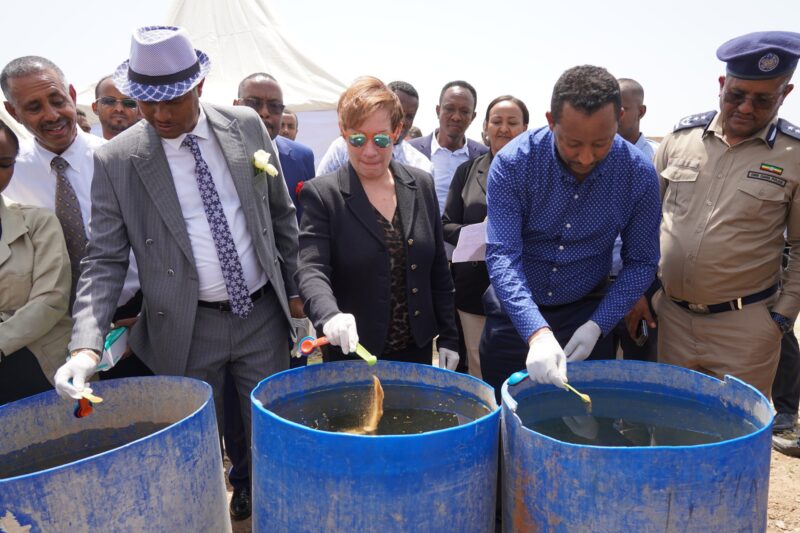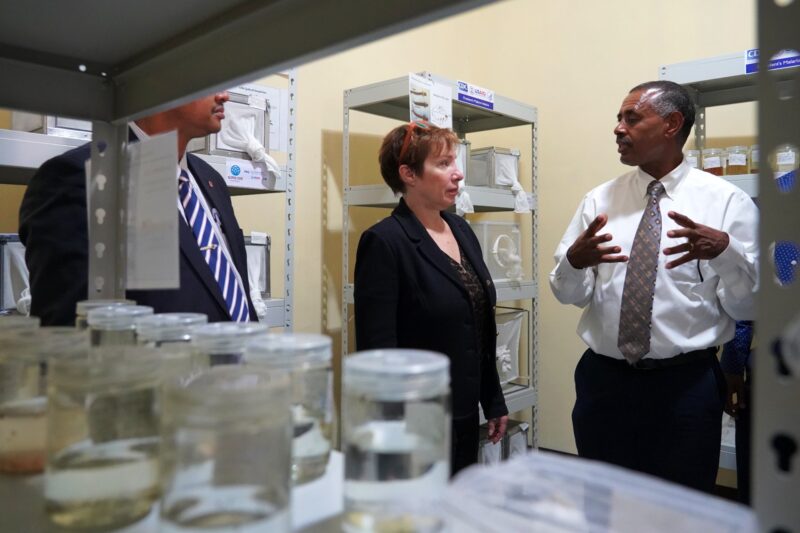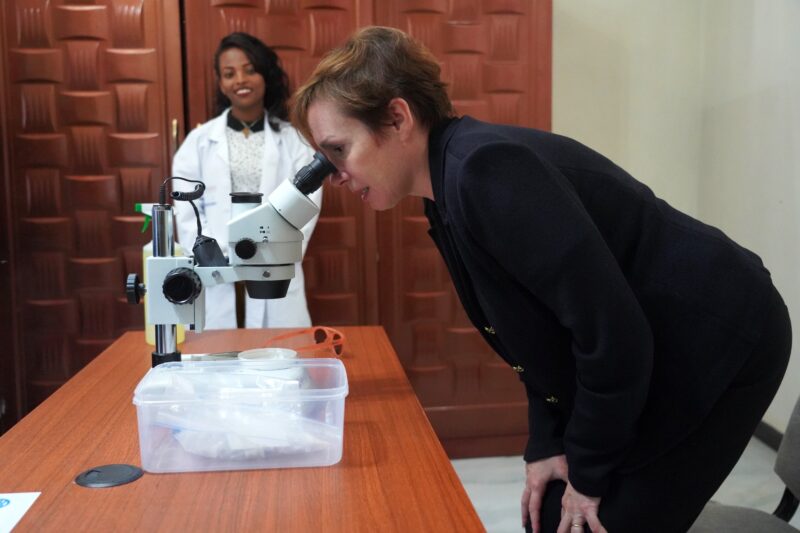Dire-Dawa is Ethiopia’s fourth most populous city, known for its bustling market and unique colorful architecture. Unfortunately the city’s latest distinction is a worrisome and unusual outbreak of malaria, a disease spread by mosquitoes that can be especially deadly for young children and pregnant women.
Historically the number of malaria cases in Dire-Dawa has been low. The city reported just 205 cases in 2019, but from January to June 2022 alone the city reported an almost 10-fold increase of 2,400 cases.
Malaria has affected humans for millennia, counting Cleopatra and Alexander the Great among its victims. Until recently, malaria in Africa was only known to be transmitted by certain mosquito species native to the continent.
Of the almost 600 mosquitoes collected from March to June 2022 in Dire-Dawa by investigators, 97% were identified as the invasive species Anopheles stephensi. It is native to the Middle East and South Asia, and was not detected in Ethiopia prior to 2016, nor in Africa prior to 2012. Now, this invasive mosquito has been detected in 45 locations throughout Ethiopia.
Africa already has 95% of the world’s malaria cases and 96% of malaria deaths. Models estimate if An. stephensi spreads across all of Africa, it could put an additional 126 million people at risk of malaria. That’s more than the populations of California, Texas, Florida, New York, and Pennsylvania combined. Models also indicate in Ethiopia alone there is a potential 50% increase in malaria cases if the mosquito spreads unchecked.
Much that malaria and mosquito experts know about An. stephensi outside of its native range has come from work in Ethiopia funded by the U.S. President’s Malaria Initiative (PMI), which is led by USAID and co-implemented with the U.S. Centers for Disease Control and Prevention. Through collaboration with the Ministry of Health, regional health bureaus, the Armauer Hansen Research Institute, and others, PMI’s assistance spans from mosquito population research to care of malaria patients.
PMI has supported the Ethiopia National Malaria Elimination Program’s efforts to drive down malaria infections and deaths since 2008 — and is not backing down now.
“New” mosquito brings new challenges needing new solutions
All mosquitoes start out as eggs laid in water that hatch into larvae, then develop into pupae, and then finally become the flying adults we all know. While most mosquitoes lay eggs in natural habitats like ponds, An. stephensi, however, prefers to lay eggs in a variety of artificial water storage containers.

Left: Twenty-two An. stephensi mosquito eggs. Center: An. stephensi mosquito larva. Right: Anopheles stephensi mosquito pupa. The adult An. stephensi female mosquito is a known vector for the disease malaria. / CDC
By thriving in these containers, the mosquitoes are able to survive year round, regardless of rainfall, leading to previously unheard of outbreaks of malaria in the dry season.
The use of these water containers is common in urban settings and Ethiopia, like many parts of Africa, is rapidly urbanizing. So while rural communities have suffered from malaria more frequently because of native mosquitoes, An. stephensi could allow the disease to also surge in Africa’s populous cities where mosquito tools like bed nets are not widely used.
Most concerning is that An. stephensi in Ethiopia do not die when exposed to the insecticide generally used to control native malaria mosquitoes and they also prefer to bite and rest outdoors. Because of this unique biology of An. stephensi, the primary tools to counter adult malaria mosquitoes — insecticide-treated nets and insecticide application to interior walls — are not the most effective tools to counter this deadly mosquito.
Instead, we need to look at killing the mosquitoes earlier in their life cycle.

U.S. Ambassador to Ethiopia Tracey Ann Jacobson (center) adds a chemical to a water container that is safe for humans but kills mosquito larvae. / William Herkewitz, USAID/Ethiopia
An effective way to control An. stephensi is to add larvicide, which is a chemical used to kill mosquitoes before they reach adulthood, to the water where they breed. This is known as larval source management (LSM). In alignment with USAID environmental policies, the larvicide used by PMI won’t harm other insects, fish, birds, and mammals, and at the recommended dose is safe for humans, including for drinking, washing dishes and other household uses, and watering crops.
Ethiopia has selected eight towns, including Dire-Dawa, for an LSM pilot with the support of PMI. In late August, the U.S. Ambassador to Ethiopia Tracey Ann Jacobson helped kick off the LSM pilot alongside the mayor of Dire-Dawa and a representative of Ethiopia’s Ministry of Health.

The ambassador visited an insectary to learn about the Anopheles stephensi mosquito that is threatening malaria progress in Africa. / William Herkewitz, USAID/Ethiopia
Mobilizing against the invasive mosquito
About 560 local seasonal workers have been hired and trained in Ethiopia for the LSM pilot, which will target all 79,000 residential, commercial, or communal properties, including houses, schools, shops, and churches, pending consent by the owners. Community vector control technicians look for water containers and apply the larvicide. Where appropriate, they also work with the community to remove water from containers, cover containers with a properly fitted lid, and flip, discard, or otherwise modify containers in order to reduce the places where An. stephensi larvae can breed.
Outfitted with sieves, pipettes, and long spoons called dippers, community mosquito collectors help track progress and monitor the An. stephensi populations by collecting larvae and pupae each week from discarded tires and buckets, and permanent water holding structures such as tanks.
The larvae and pupae are sent to the temporary insectary in town where a technician carefully raises them to adulthood for proper identification and further study. Community mosquito collectors also collect adult mosquitoes from homes and livestock structures about 300 feet away from places where An. stephensi larvae are found and send them to collaborating universities for analysis.

PMI is ensuring that research from Ethiopia is shared rapidly with the global community to allow for the early detection and rapid response to An. stephensi. / William Herkewitz, USAID/Ethiopia
This work is generating the data needed to pave the way for the global response to An. stephensi. PMI is ensuring that information from Ethiopia is shared rapidly with the global community to allow for the early detection and rapid response to An. stephensi in new locations.
“I am proud of PMI’s efforts to support Ethiopia in helping to lead the world in collecting data and mitigating the impacts of invasive Anopheles stephensi. Countries all over the world are looking at the approach and data from Ethiopia to understand and respond to this threat,” says Dr. David Walton, the U.S. Global Malaria Coordinator.
Top photo: Anopheles stephensi is a mosquito not native to Africa but in recent years has been found on the continent. / James Gathany,CDC
This story originally appeared on USAID Medium
